The Official Blog of Morningside Nannies
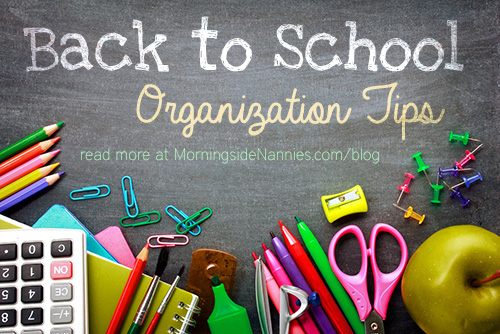
Now that you’ve transitioned into the back to school routine, you’ve probably been faced with dealing with the enormous amount of stuff that comes home from school each day. From important papers that need to be returned to school, to your child’s latest art class masterpiece, sorting, organizing and displaying all that comes homes may prove to be a bit of challenge.
But fear not! The next time you empty out your child’s backpack, put these 5 tips to the test to make dealing with school stuff more manageable.
1. Give your child a home/school folder.
Pick up a two pocket folder or recycle one from your own office supplies. Plastic ones will work better than paper as they are more durable. Write your child’s name on the front. Label one inside pocket “home” and the other pocket “school.” Have your child put anything that comes home from school on the home side. Put anything that needs to go back on the school side. Keep this folder in your child’s backpack so it travels back and forth from home to school with him.
2. Put up some twine.
Take a piece of twine and hang it across a wall in the living room. Add clothes pins to the twine. As your child brings artwork home, proudly display it by hanging it up on the twine. As new pieces come in and you take older ones off, be choosey about the ones you opt to hold on to. Snap a photo with your digital camera of the rest, and at the end of the year compile and print out a photo book of your child’s artwork.
3. Hang some hooks.
No one wants to have a before school scavenger hunt. The entry way can be the perfect place to hang a few hooks to store jackets and backpacks. Be sure to have your child load up her backpack each evening once she is finished her homework with what is needed for the next day. Add a basket by the door to store shoes. Keeping everything together in a set place can make getting out the door in the morning a cinch.
4. Keep important things handy.
Your child’s school calendar. Emergency school contacts. Your child’s specials schedule that reminds you which day is gym. Laminate these and add them to a three ring binder that is easy to access. Take photos of these documents with your phone so they’re always handy.
5. Select your storage space.
Have a set place to keep your child’s lunch box, instrument and library books. Dedicate a storage spot to anything that comes home and goes back to school with your child so you’re not left searching for something as you’re heading out the door.
Taking a systematic approach to managing what comes home and goes back to school can help to keep clutter and disorganization at bay. Putting together a plan for organizing school stuff can help you to track what’s going on at school and ensure both you and the kids can find what you need when you need it most.
Posted in
Advice for Nannies,
Advice for Parents,
Houston |
Comments Off on Back to School Organization Tips
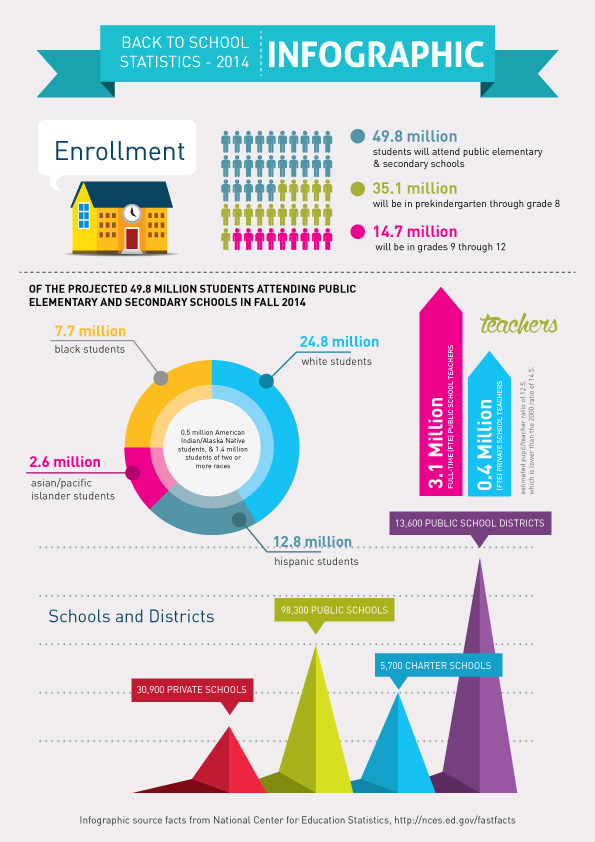
Posted in
Advice for Nannies,
Advice for Parents,
Houston |
Comments Off on BACK TO SCHOOL STATISTICS for 2014
 There’s no shortage of ways to stay fit if you’re working in Houston. From running to CrossFit, and everything in between, there’s something for everyone who’s looking to break a sweat.
There’s no shortage of ways to stay fit if you’re working in Houston. From running to CrossFit, and everything in between, there’s something for everyone who’s looking to break a sweat.
If you’re a runner, check out these trails:
- Terry Hershey Park: Located just off of I10 and the Beltway, Terry Hershey Park boasts miles and miles of paved trails for runners to enjoy. The trails are tucked away in a serene setting filled with trees, wildlife and water – you won’t even realize you’re right next to two major freeways!
- Memorial Park: At Memorial Park you’ll find an easy-to-follow a 2.88-mile dirt pathway that is always filled with runners. Because the path is a big loop, Memorial Park is an easy favorite for runners who want to run without worry of getting lost.
- Hermann Park Trail: Runners will enjoy a variety of scenery and a dirt running trail that is easy on the joints. From the park’s website: “Joggers love following the 2-mile Marvin Taylor Exercise Trail around the golf course under the shade of the Park’s historic live oaks.”
If you do CrossFit, head to one of these boxes:
- CrossFit EaDo: This box boasts that it’s the biggest CrossFit box in Texas, and has received rave reviews for not just the box itself, but also the coaches.
- CrossFit H-Town: Named one of the top 15 CrossFit boxes in America, CrossFit H-Town is a celebrated box in downtown Houston that serious CrossFitters will love.
- CrossFit Roughnecks: Located in the heart of Downtown Houston, CrossFitters who work in the city will love the ease of access to this box.
If you’re a yogi, find your inner peace at one of these studios:
- YogaOne: YogaOne has five different locations around the Houston area and offers Hot Yoga, Forrest Yoga and Vinyasa Flow classes. These studios are a favorite among Houstonians.
- Republic Yoga Studios: Classes at Republic Yoga Studios are capped at 14 students so that each student gets the personalized attention they need and deserve. Students will find this unique setting a breath of fresh air from bigger studios where it’s easy to get lost in the shuffle.
- Jennyoga: Jennyoga describes their studio as, “an open and supportive community committed to the study and celebration of yoga.” The studio specializes in Hatha yoga forms, offering classes for everyone from beginners to the more advanced student.
If you’re looking for cycling classes, head to one of these spin studios:
- My Indoor Cycle: Small classes, upbeat instructors and top of the line spin bikes make My Indoor Cycle one of the best spin studios in Houston. Spin enthusiasts also enjoy no contracts and low drop-in rates.
- Define Body and Mind: Define Revolution promises to combine “principles of isometrics with cardio-blasting, high intensity fun”. But don’t just stop at the spin classes; Define offers several other types of group classes as well, allowing you to explore all areas of fitness.
- Revolution: Everyone is welcome at Revolution Studio, no matter what your fitness level or spin experience. From the website: “In each class, your instructor will lead the way, suggesting target resistance levels and movements but YOU decide what is right for you with individual resistance knobs located on each bike.”
These classes only scratch the surface of the options available for fitness enthusiasts in Houston. Whatever your preferred method for getting fit, Houston is sure to have it!
Posted in
Activities,
Advice for Parents,
Houston |
Comments Off on Ways to Stay Fit When Working in Houston
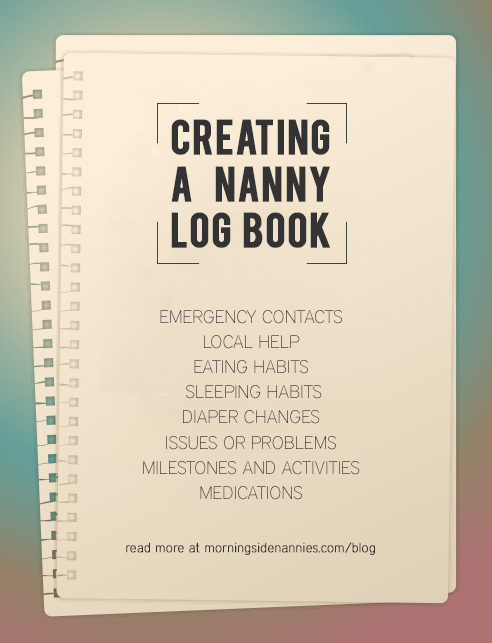 Having a nanny to care for your child when you can’t is a great asset and one way to make your relationship even better is through a Nanny Log Book. A Nanny Log Books allows you and your nanny to communicate easily and effectively every day. It allows you to see what your child is eating and doing during the day and keep on top of any problems as they arise. Here are some tips to create a Nanny Log Book:
Having a nanny to care for your child when you can’t is a great asset and one way to make your relationship even better is through a Nanny Log Book. A Nanny Log Books allows you and your nanny to communicate easily and effectively every day. It allows you to see what your child is eating and doing during the day and keep on top of any problems as they arise. Here are some tips to create a Nanny Log Book:
1. Emergency Contacts
One of the first sections of a Nanny Log Book should be a list of emergency contacts. If something should happen when your nanny is home alone with your child and can’t reach you, they should be able to call many other numbers to get help. Phone numbers for friends, relatives or even neighbors should be easy to find in case of emergency.
2. Local Help
Along with personal contacts, your Nanny Log Books should also contain local help. The fire department, police department and other local numbers should be listed. A neighbor that can help is great, but professional help is sometimes needed. The number and address for the local hospital and your child’s pediatrician should also be included.
3. Eating Habits
– Now we can move on to things the nanny needs to include in the Log Book. One suggestion is to include eating habits. With infants, she should log times fed and burped. With older kids, she should note what they ate, how much, and at what times. Not only will this help you to make sure your kids have a balanced and healthy diet, but you can also note any allergic reactions they might have and keep their eating on schedule on the days you have them to yourself.
4. Sleeping Habits
Nap time, bed time and getting up in the morning should always be noted for your child. This can help set up a routine to make sleeping easier and ensure your child stays well rested.
5. Diaper Changes
Another important thing to include in the Nanny Log Book is diaper changes or potty times. Potty training is an important part of a child’s life and having a consistent schedule between you and the nanny is vital. Notations of color or consistency can also help to make sure that the child is digesting food properly.
6. Issues or Problems
As the day goes on, problems from the morning may slip a nanny’s mind. Or you might come in tired and too exhausted to have a long conversation. Having a Log Book where the nanny can note problems or issues with your child throughout the day can be a simple way to see patterns of behavior and work with your nanny to correct them.
7. Milestones and Activities
Another great thing to log is milestones. The baby rolling over, the young child reciting his ABC’s, an older child doing the dishes, and so on can be shared with you through a Nanny Log Book. Even photos or recordings of the event can be shared if your Nanny Log Book is on a computer.
8. Medications
If your child is ill or takes medications regularly, it is important to keep track of doses and times. Having a Log Book can help keep your child well and on schedule and help to ensure that your child isn’t over or under medicated.
Creating a Nanny Log Book can give insight into your child’s day. From meal time to nap time, sharing information is vital to making sure your child gets the care he deserves and that you stay in the loop.
Posted in
Advice for Nannies,
All About Nannies,
Houston |
Comments Off on Creating a Nanny Log Book
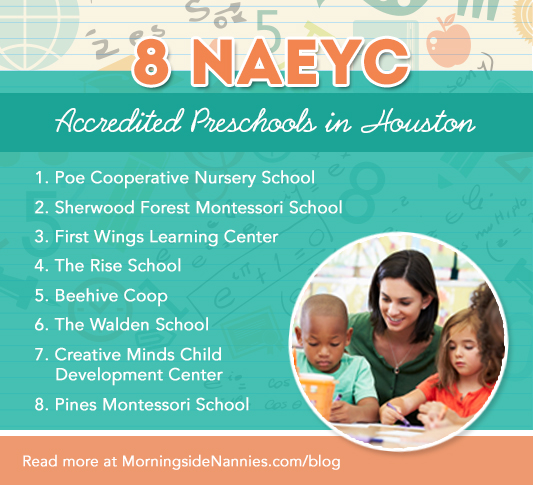 Safe and educational childcare is a priority for all parents. But how do you determine which preschools offer the services you want for your child? Accreditation is a great way to make sure that your preschool offers the opportunities you want for your child. The National Association for the Education of Young Children (NAEYC) “has set 10 standards for early childhood programs that can help families make the right choice when they are looking for a child care center, preschool, or kindergarten. The standards and criteria are also the foundation of the NAEYC Accreditation system for early childhood programs. To earn accreditation, programs must meet all 10 standards. Based on research on the development and education of young children, the standards were created with input from experts and educators from around the country. The standards define what NAEYC—the world’s largest organization of early childhood professionals—believes all early childhood programs should provide.” Here are some Houston area preschools that are accredited by NAEYC:
Safe and educational childcare is a priority for all parents. But how do you determine which preschools offer the services you want for your child? Accreditation is a great way to make sure that your preschool offers the opportunities you want for your child. The National Association for the Education of Young Children (NAEYC) “has set 10 standards for early childhood programs that can help families make the right choice when they are looking for a child care center, preschool, or kindergarten. The standards and criteria are also the foundation of the NAEYC Accreditation system for early childhood programs. To earn accreditation, programs must meet all 10 standards. Based on research on the development and education of young children, the standards were created with input from experts and educators from around the country. The standards define what NAEYC—the world’s largest organization of early childhood professionals—believes all early childhood programs should provide.” Here are some Houston area preschools that are accredited by NAEYC:
“In April, 1991 Poe-Co became the first parent cooperative preschool to achieve N.A.E.Y.C. accreditation.” As a co-op, Poe believes in involving parents in the education of their children. Parents volunteer to help out in the classroom and the whole family is involved in the education of the children. Not only does Poe help preschool students succeed, but they are affiliated with Poe Elementary School, allowing the children to have a seamless transition from preschool to grade school.
Another great preschool choice with a focus on education is Sherwood Forest Montessori School. A Montessori school might not be the right fit for all children, but it does offer a unique learning experience. The school enrolls children from 18 months through the sixth grade. “Founded in 1977, Sherwood Forest Montessori School is an independent learning environment specifically designed for young children and their individual needs.”
“Established in 1994, First Wings Learning Center originally opened to serve children of the Houston Air Traffic Control Center (ZHU) and then at a later date services were extended to the general public.” A different take on preschool, this airplane themed atmosphere could be the perfect choice for those who live close to George Bush Intercontinental Airport. Believing in active and fun activities as a way of learning, the school promotes singing, storytelling and game play.
A special school for special students, The Rise School is “dedicated to educating young children born with Down syndrome and developmental disabilities alongside their traditional-learning peers.” But even if your child does not have a disability, The Rise School may still be a good choice. “Every year Rise enrolls traditional learners that make up 30% of the student body. For a traditional learner, Rise exceeds a typical preschool environment with small student to teacher ratios, one on one learning plans, master’s level teachers and an inclusive environment not found anywhere else in Houston.”
Another cooperative preschool program, Beehive stresses parental involvement. “The program is designed to foster positive feelings towards school so that children will leave the program eager to continue learning in both formal and informal settings. Because parents attend Beehive with their children, parents demonstrate to their children the value they place on education and encourage a lifelong habit of learning.” For some parents, Beehive may be a great way to introduce your child to a traditional learning environment while still remaining highly involved in their education.
Located in Sugar Land, just south of Houston, the Walden School offers education for children 6 weeks of age through 12 years. Parental involvement is also stressed at this school, as is a focus on self-esteem. “Open communication with staff and directors is encouraged, and a variety of activities are planned especially to involve parents in special events in their child’s school activities.”
Also located in Sugar Land, Creative Minds has the goal of creating lifelong learners. “We help children become independent, self-confident, inquisitive learners by providing an environment that allows children to learn by doing. Our curriculum encourages children to be active and creative explorers. We teach kids how to learn, not just in preschool, but all through their lives.” Active outdoor time and learning fun factor heavily into the curriculum.
Located in Kingwood near the Creekwood Nature Reserve, north of Houston, Pines has been an educational anchor since 1977. They “are the largest Montessori school in the area and serve the widest range of ages, from 6 weeks through 15 years (8th grade).” In order to help children learn real life skills, they “offer a challenging, lively curriculum that emphasizes the fundamentals of learning and encourages young scholars to communicate, reason, and think. We regard proficiency in reading and mathematics to be essential, not as ends in themselves, but because these basics are the keys to life-long success.”
There are more accredited preschools in and near Houston, including many religiously affiliated ones. Find the right preschool for your child and check accreditation to make sure they meet your expectations.
Posted in
Advice for Parents,
Houston |
Comments Off on 8 NAEYC Accredited Preschools in Houston
 Looking for some fun things to do this summer in Houston? Look no further. Beat summer boredom by taking advantage of some of these family events, date ideas for couples, kids-only activities and more.
Looking for some fun things to do this summer in Houston? Look no further. Beat summer boredom by taking advantage of some of these family events, date ideas for couples, kids-only activities and more.
As a Family
Sometimes you just need some good family fun. Check out these 10 ideas for summer fun!
- Catch Pippi Longstocking: The Family Musical. Head out to the Main Street Theater at Chelsea Market to giggle at the adventures of this precocious red head. The show plays through August 4, 2014. Check theater for new shows.
- Rent a pedal boat. For just $10 for 30 minutes the family can rent a pedal boat and pedal around the pond at Hermann Park. Bring along some bread or crackers to feed the ducks, then go to the fountain to cool off.
- Attend Shakespeare in the Park. The Shakespeare Festival is held at the Miller Outdoor Theater. Check with the University of Houston for current offerings.
- Watch a Movie Under the Moon. Watch a movie outside and bring a picnic supper or snacks at First Colony Church of Christ. Movies are played once a month.
- Go to a Swift Night Out Events. Head to the Nature Discover Center to join in the fun of counting chimney swifts, which are birds that nest in chimneys. These events are perfect for the whole family and run from August to September.
- Watch the bats emerge at sunset. This family event takes place on the first and third Friday all year. Come about a half hour before sunset to hear a presentation about the bats and why they act the way they do at the Waugh Bridge. The city has some guidelines you can check out at Houston TX.
- Rent and drive model boats. The Model Boat Basin located at Discovery Green rents boats for $5 for half an hour or you can bring your own model boat for free.
- Bring the whole family to watch some baseball. Houston is home to the Astros professional baseball team. Check the schedule to get your tickets for the next game. Ticket prices vary.
- Have a blast riding bumper boats, go karts and more. Zuma Fun Centers includes arcades, batting cages, mini golf, kids’ rides, go karts and bumper boats for family fun time. Go as a family or bring some friends for a birthday party. You can enjoy an all-day pass for $23.99.
- Visit the wild animals. The Houston Zoo houses over 6000 animals that you can visit daily. Explore Natural Encounters, which lets you get up close and personal with the wildlife.
Just for Kids
Looking for something just for the kids? These 10 ideas will help keep the kids from being bored this summer.
- Check out the Pre-School “Beat the Heat series”. Bring the kids to the Rosenburg Railroad Museum every Wednesday throughout the summer. The kids enjoy a story, a craft and a snack for a nominal charge. Stay and tour the museum at a reduced rate.
- Learn the basics of kayaking. For $5 per child you can hire a guide to show your kids how to paddle around the pond at Discovery Green. The kids get to practice paddling and enjoy watching the wildlife on the pond. No reservation is required.
- Discover your “super power”. Take a trip to the Children’s Museum where the theme this summer is The Summer of Epic Adventure: Where Superheroes Discover their Powers. Bring the kids in their favorite super hero costume so that they can discover their own super power. Tickets are $9 for adults and kids.
- Burn off some energy at the gym. My Gym that is. From 6 weeks to 13 years, your kids can stay fit and have fun. Try your first class for free to see if your kids love it. During the summer you can get two classes for the price of one.
- Enjoy some good clean fun. Leave the electronic games at home and let the kids enjoy the petting zoo, zip line, rock wall, horse shoe pit, sand box and more at 7 Acre Wood. Kids can even take a pony ride. Prices start at $6 for admission and then you pay for extra activities, like paintball, once inside.
- Get the acting bug. Upstage Arts is a theater where kids can get cast in a play or simply enjoy watching a performance. This experience is open to kids of all ages, but certain shows may be limited. Tuition varies depending on show.
- Go bowling. Beat the heat and head inside to Main Event for bowling, laser tag, billiards, rock climbing, gravity, bocce ball and more. Spend the day for only $15.95 per person.
- Visit the aquarium. Take the kids to the Downtown Aquarium for some deep sea fun. Kids can touch live sting rays and ride the shark voyage train through a 200,000 gallon tank full of sharks. Enjoy the view from the Ferris wheel and ride the sea life figures on the carousel. Tickets are $18.99 for an all-day pass.
- Blast off to outer space. Let the kids imagine themselves as astronauts at NASA. Get the wiggles out in the giant climbing structure and try holding a live snake. The theater shows two movies, Space Shuttle Launching and Destination Station: The International Space Station. Plan on spending the entire day as there is a lot to do.
- Stroll down the boardwalk. Head to Kemah for a day at the amusement park. The kids will love the rides and attractions, while mom and dad will love the nostalgia of it all. Tickets are $22.99 for kids and adults 48 inches and up and kids less than 48 inches are $17.99.
Adventure Seekers
If you are looking for adventure, there are a lot of things to choose from in Houston. You can zip line, bull ride, horseback ride, deep sea fish, parasail and more.
- Face your fear of heights. Head to Moody Gardens to try your skills on the tallest ropes course on the Gulf coast, then take a turn on the zip lines. Prices for the ropes course are $18 and the zip line is $18 or you can purchase both for $27.
- Saddle up. Spend some time with the guide on a trail ride or venture off to an endurance competition with Cypress Trails. Lessons are available in endurance riding and Adventure Trail Rides start at $50 for an hour and go up to $135 for all day. Meals can be included for a fee.
- Go bull riding. Come to the Houston Livestock Show and Rodeo to watch or enter the bull riding event. You can also enter the barrel racing and bareback riding events. The cowboys and girls that enter these events can win some pretty big money.
- Cast your line. Ever wanted to catch a fish big enough that you didn’t have to exaggerate its size? Try your hand at deep sea fishing off the gulf coast. Charter a boat with Get Hooked Fishing and learn how to catch the big ones.
- Try scuba diving. Houston Scuba Academy provides scuba diving lessons and certification. They also host diving trips that you can go on once you are certified.
- Go water skiing. Take advanced water skiing lessons with M2 Sports. Lessons start at $45 for 25 minutes.
- Fly up and away. Enjoy a bird’s eye view of the gulf when you go parasailing! Prices start at $90 when you go to Galveston Parasail.
- Feel like a bird and go soaring. Take a test flight on a sail plane with another pilot at the Greater Houston Soaring Association. 30 minute flights are $75.
- Get a workout and go rock climbing. Stone Moves Indoor Rock Climbing has extensive indoor climbing routes that change monthly. Practice the basics and learn advanced rock climbing moves at this indoor location.
- Work on landing an Ollie. Head to Lee and Joe Jamail Skatepark to practice your daredevil skateboarding moves. Not only can you work on an Ollie, but you can practice your kick flip and spins, too. There’s no charge to skate at the park, but you need your own equipment.
Couples Only
Reserve a nanny for the night and enjoy an evening out on the town. These 10 ideas are perfect for a date night.
- Float above Houston to celebrate a special event. Hot air balloon rides are romantic and allow you and your loved one to enjoy a spectacular view of Houston. Prices vary, but two people cost around $400 at Soaring Adventures of America.
- Go to a wine tasting. Pleasant Hill Winery is open for tasting and shopping on the weekend. Come on a Saturday at 11am or Sunday at 12pm. Check out the various wines they have on their site.
- Learn to cook. Take a cooking class together at Well Done Cooking Classes. The roasted chicken class starts at $89 per person.
- Relax with a couples massage. Petit Retreat offers several options for a romantic afternoon or evening. A side by side one hour massage is $180 and you can enjoy further relaxation in the Jacuzzi for an additional $70.
- Enjoy some music. Live music and dinner is available at The House of Blues. Shows vary, so check to see what’s playing before making a reservation.
- Take a romantic horse drawn carriage ride. A to Z Events offers horse drawn carriage tours of downtown Houston. Pick up is at the Aquarium and you can reserve a set time by calling and paying ahead.
- Head to the drive-in. Enjoy a flash back date night by eating dinner at a local diner and then heading to The Showboat Drive-in. Tickets for adults are $6 each. First run movies start at dusk.
- Try a dinner cruise for a romantic evening. Boardwalk Fantasea Dinner Cruises provide a three hour tour of Clear Lake while you enjoy dinner. If you head out on Friday night you can even see the fireworks over Kemah. Prices start at $99.99 per person.
- Go for dinner and a movie at the same time. Studio Movie Grill has a full bar and kitchen where you can enjoy cocktails and dinner while enjoying first run movies in comfortable chairs.
- Take in a view of the city. Head to the observation deck at the top of JP Morgan Chase Tower to get fabulous pictures of the incredible view. There’s no charge to head up to the 60th floor, but it’s only open during business hours.
Summer Cool Down
There’s no shortage of places to go to cool off on a hot summer day in Houston. From city pools to splash pads to water parks and swimming holes, there’s something for everyone.
- Splash Town. Come enjoy the water slides, wave pool and brand new Flow Rider surfing ride at Splash Town. Tickets are $34.99 for adults and $30.99 for kids under 48 inches. Soft sided coolers filled with water bottles are allowed inside the park. There are picnic tables outside the park to enjoy a picnic lunch or you can buy food inside.
- Schlitterbahn Waterpark. Spend the day staying cool and having a great time at Schlitterbahn, which is home to the Whitewater River, Torrent River, Soaring Eagle Zip Line and more. Tickets are $55.98 for adults and $45.98 for kids and include a refillable souvenir bottle.
- Head to a splash pad. There are over 27 different splash pads in Houston. Each splash pad has its own theme, so be sure to try more than one.
- Try out a place that has water rides and zip lines. Splashway is a water park complete with a lazy river, wave pool, slides and more. They also recently added zip lines to the property. Tickets for the water park are $24.99 and the zip lines are $45. There are also campgrounds with cabins close by.
- Get lost in the space bowl or drenched under the bucket. Try these attractions and more when you go to Baytown. In addition to the standard water slides, Baytown also has exciting attractions like the space bowl, a surf machine and the relaxing lazy river. Prices start at $15 for kids under 48 inches and $20 for everyone else.
- Swim at an area pool. You can find a listing of all of the pools in Houston on the city website. These pools offer swimming lessons for the young and water exercise classes for the young at heart.
- Try out for the swim team. Check out the YMCA for the details on trying out and joining the swim team. You can also attend swimming lessons through the YMCA.
- Dive right in. Head over to W. W. Emmons Natatorium for diving practice. In addition to diving, competitive swimmers can enjoy the 25 yard lap pool.
- Swim in the ocean and ride the waves. Mustang Island has beaches where you can build sand castles and body surf on the waves. You may even be able to find some pretty shells to collect.
- Find a local swimming hole. If you are looking for a fresh water option, try a local swimming hole. Check out the list of 10 on TPW Magazine.
Posted in
Activities,
Houston |
Comments Off on 50 Things to do This Summer in Houston
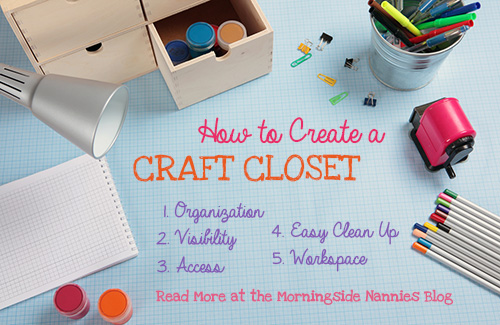 Most nannies love to do crafts with kids, but having craft stuff scattered around the house makes it hard to get started. From crayons in the toy box to wrapping paper in the attic, finding everything you need to do crafts can be frustrating if you don’t have a centralized crafting area. That is where a craft closet comes in handy. You do not need to make a whole room into a crafting space to have an organized and useful place to store your craft goods. Consider asking your employer if a broom closet or other small storage space can be converted into a craft closet for the kids..
Most nannies love to do crafts with kids, but having craft stuff scattered around the house makes it hard to get started. From crayons in the toy box to wrapping paper in the attic, finding everything you need to do crafts can be frustrating if you don’t have a centralized crafting area. That is where a craft closet comes in handy. You do not need to make a whole room into a crafting space to have an organized and useful place to store your craft goods. Consider asking your employer if a broom closet or other small storage space can be converted into a craft closet for the kids..
Once you’ve got the approval to create a space, here are some tips for creating and maintaining a craft closet:
1. Organization
First things first. Organization is the key to making your craft closet work. Tossing in a bunch of craft goods just won’t work. It is not any better than having them scattered throughout the house. Instead, invest in bins, shelves and other organizational storage units to make the most of your small space. Make sure you have a place for everything so that you can find it easily when you need it.
2. Visibility
Another aspect of crafting is inspiration. You can use things you have left over from other projects to create something new. But if you can’t see what you have, how will you ever use it? Make things visible in your craft closet by using clear storage solutions. Bins with clear doors, wire racks and open hangers all allow you to see what you have on hand so you can use and be inspired by it.
3. Access
Kid and adult friendly access is paramount to a successful craft closet. For kid crafts like coloring and finger-paints you may want to keep these items low enough for them to reach. Potentially dangerous items like scissors and needles should be kept on higher shelves that only adults can access. That way you feel safe sending your child to retrieve something from the craft closet for their own craft adventures. Having easy to open bins and easy to access shelves also helps to keep craft goods on hand when you need them. From paper to bags to ribbon, your craft closet should be easy to access.
4. Easy Clean Up
When your craft closet is organized it’s easier to clean up. Another aspect of this is labeling. Having labeled areas for each type of craft good makes it easier for them to be properly put away. Items like butcher paper and newspaper should also be stored with your craft goods to make cleaning up after messy crafts like glitter easier. Laying out a few layers of paper can make cleaning up a snap and help make crafting less stressful and more fun.
5. Workspace
Last but not least is a workspace. Although you might not have an entire room devoted to crafting your craft closet can be a space to work in too. A fold down table can easily be placed up out of the way and gotten out for craft projects in a snap. Even tables meant to fold laundry are great additions to a craft closet and make it even more usable and craft friendly.
Making a craft closet doesn’t have to be a big deal. You probably have almost everything you need already. If you don’t, consider asking your employer for a small budget to stock up on supplies. Setting aside a special craft area can help you make the most of your crafting time together and cut back on time spent searching for crafting supplies.
Posted in
Activities,
Advice for Nannies,
Advice for Parents,
Houston |
Comments Off on How to Create a Craft Closet
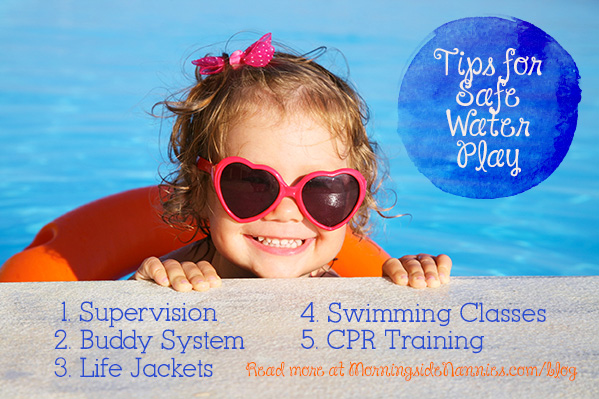 Summer is a great time to get outside and cool off in the water, but if you have children then water safety should be on your mind. According to Safe Kids Worldwide, “Drowning is the leading cause of injury-related death among children between 1 and 4 years old. And it’s the third leading cause of death among children.” How can you keep your children safe around water?
Summer is a great time to get outside and cool off in the water, but if you have children then water safety should be on your mind. According to Safe Kids Worldwide, “Drowning is the leading cause of injury-related death among children between 1 and 4 years old. And it’s the third leading cause of death among children.” How can you keep your children safe around water?
1. Supervision
Watching children around water seems like a no brainer, but constant supervision is easier said than done. Cell phones, talking to friends, bathroom breaks and so on all give parents and caregivers opportunities to take their eyes off of their children long enough to cause problems. Do not trust shallow water either, as small children and babies can drown in as little as one inch of water. If there is more than one adult present, make sure you know who is responsible for watching the children. Lifeguards are a great asset, but do not depend on them to watch your kids. They have a whole pool full of kids to watch! If you have a pool or other body of water near your home, make sure there is no danger of children accessing it without supervision. Gates and pool covers help prevent this danger.
2. Buddy System
Another great way to make sure kids are safe around water is to use a buddy system. Have inexperienced swimmers stay with an adult or experienced swimmer at all times. No one should ever swim alone as cramps, entanglements and other dangers can take down even the best swimmers. According to the Red Cross you should “Avoid alcohol use. Alcohol impairs judgment, balance and coordination; affects swimming and diving skills; and reduces the body’s ability to stay warm.”
3. Life Jackets
Safe Kids Worldwide recommends having, “your children wear a life jacket approved by the U.S. Coast Guard while on boats, around open bodies of water or when participating in water sports. Make sure the life jacket fits snugly. Have the child make a “touchdown” signal by raising both arms straight up; if the life jacket hits the child’s chin or ears, it may be too big or the straps may be too loose.” In fact, they mention the statistic that “In 2011, 70 percent of all fatal boating accident victims drowned, and of those who drowned, 84 percent were not wearing a life jacket. “
4. Swimming Classes
According to the Red Cross, “the best thing you can do to help your family stay safe is to enroll in age-appropriate swim lessons.” Teaching children to be strong swimmers can help prevent some accidents, but swimming lessons also teach important ideas like: taking breaks to prevent overtiredness, preventing hypothermia, proper breathing, and how to react calmly to incidents in water.
5. CPR Training
Another way you can have peace of mind around water is by learning CPR. Many local hospitals, fire departments and recreation departments offer CPR training for little or no cost. Learning what to do in case the worst should happen is a great way to be prepared.
Playing in and around water is a great way to spend the hot summer months. However, you should remember that children need to be constantly supervised, no matter how responsible they seem. You should take the proper precautions when playing in or near water to ensure your child’s safety.
Posted in
Activities,
Advice for Nannies,
Advice for Parents,
Houston |
Comments Off on Tips for Safe Water Play
 When conducting your job search, it’s vital that you know your market value. To determine wage expectations, many nannies simply add up their expenses each month and set their salary requirements based on those results. Others come up with with a random wage requirement that they are satisfied with and set that as their earning goal. Some even base their wage requirements on what they believe the parents can afford to pay them given where they live and the type of car they drive. And a few see advertisements for high-end positions posted on recruiting websites and assume that’s the norm. Unfortunately, these are not accurate ways to determine a nanny’s market value and earning potential.
When conducting your job search, it’s vital that you know your market value. To determine wage expectations, many nannies simply add up their expenses each month and set their salary requirements based on those results. Others come up with with a random wage requirement that they are satisfied with and set that as their earning goal. Some even base their wage requirements on what they believe the parents can afford to pay them given where they live and the type of car they drive. And a few see advertisements for high-end positions posted on recruiting websites and assume that’s the norm. Unfortunately, these are not accurate ways to determine a nanny’s market value and earning potential.
The International Nanny Association conducts an annual salary and benefits survey each year. You can review the results of these surveys at https://nanny.org/resources/industry-services/salary-and-benefits-survey/. In Houston, we fall slightly under the national average of each year. Most of jobs place at $16 to $20 per hour for full-time positions and $18 to $22 for part-time ones.
How can you fairly assess your market value and earning potential starting from this base wage range?
Consider your experience.
How long have you been a nanny? What ages of children do you have experience with? Have you worked with other household staff? Are you a full-charge nanny? What duties and responsibilities have you taken on in previous positions?
Consider your references.
What do those who you have worked for say about you? Are the parents giving glowing references or are they just willing to verify employment? Do you have references and reference letters to support your work history and timeline? If you want to work with newborns, do you have a reference from a parent of a newborn?
Consider your niche.
Do you have a specialization? Do you only work with multiples? Newborns? Preschoolers? Do you have a history of staying with a family for 5 plus years? Do you have lots of experience working with children who have special needs? Or who were adopted? Are you a household manager? Do you specialize in working with older children? Are you experienced in the Montessori approach? Are you able to tutor school aged children?
Consider your educational background.
Do you have a college degree in early childhood education? Do you attend NAEYC workshops? Do you have specialized training? Did you take child development courses? How do you stay current with best practices in childcare?
Consider your credentials.
Are you a newborn care specialist? Are you an INA Credentialed Nanny? Are you a Child Development Associate? Do you have a teaching credential? Are you a certified nurse’s assistant? Are you a home health aide? Are you a licensed daycare provider?
Consider your affiliations.
Are you a member of the International Nanny Association? Are you involved with a local nanny support group? Do you attend nanny or educational conferences?
Consider your skill set.
Are you a certified life guard? Can you speak a different language? Do you have a gift for teaching music or are you especially crafty? Are you a former camp counselor? Can you tutor or teach a foreign language? Have you homeschooled?
Consider what you are willing to do.
Are you willing to take on housekeeping related tasks that aren’t child related? Are you willing to prepare family meals? Can you travel with the family? Can you stay overnight or be extremely flexible with your schedule? Will you work for a stay at home parent? Will you iron?
Consider the employment package.
Families are not legally required to offer employment benefits. Some do, as they know they have to in order to be competitive and to attract and retain qualified help. Standard nanny benefits include one to two weeks of paid vacation and paid holidays. Some families will also offer paid personal or sick days or contributions to health insurance. We strongly encourage our families to offer pay 52 weeks per year as well as paid vacation time and paid holidays, at a minimum. Depending on the benefits offered, the hourly wage rate may be impacted.
Like with any industry, the more experienced and educated you are, the higher your earning potential becomes. The more you are willing to work and do, the higher your earning potential becomes. The more specialized experience you have, the higher your earning potential becomes. When considering your market value and wage requirements, please be able to justify why you are expecting a wage outside of local averages. We will gladly present you with your requested wage rate to families, but we need to be able to justify to parents why you are worth a wage rate that is outside of the local Houston average.
Posted in
Advice for Nannies,
All About Nannies |
Comments Off on Do You Know Your Market Value?
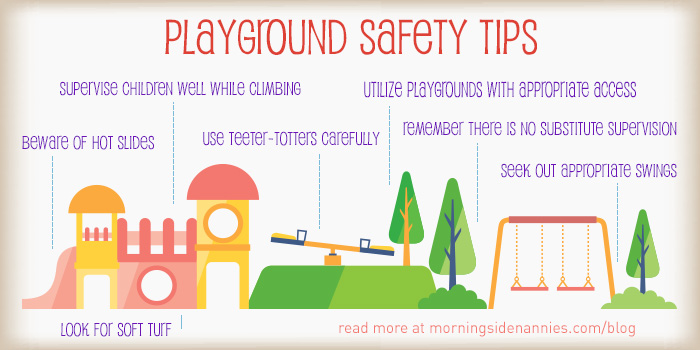 Playgrounds are a great place to take your child for active, social fun. However, they are also a hotbed for injuries. According to the National Safety Council, “Each year more than 200,000 children visit hospital emergency rooms because of playground injuries.” What can you do to prevent your child from being hurt while on the playground?
Playgrounds are a great place to take your child for active, social fun. However, they are also a hotbed for injuries. According to the National Safety Council, “Each year more than 200,000 children visit hospital emergency rooms because of playground injuries.” What can you do to prevent your child from being hurt while on the playground?
1. Look For Soft Turf
Make sure that the playground has a soft surface in case of falls. Children falling off play equipment and swings often are injured if playing on a hard surface. Most playgrounds now have soft surfaces such as mulch or rubber mats. Inspect the surfaces and make sure they are properly maintained and are large enough to handle any kind of fall.
2. Seek Out Appropriate Swings
Soft swings should be far enough apart from each other and from the play equipment to assure children will not hit anything while swinging. Bucket seats should be used for younger children and all children should be closely supervised while swinging to make sure they don’t jump out, let go, or try to stop too quickly and possibly injure themselves. Children should not go close to the swings while in use either.
3. Beware of Hot Slides
During the summer, metal and even plastic slides can become very hot. Make sure you touch the slide to make sure it is not too hot for your child. Children should always sit when sliding and loose clothing should not be worn as it can get caught and poses a choking hazard.
4. Use Teeter-totters Carefully
Although many parks no longer have teeter-totters due to safety concerns, there are some variations that are safe for children to use. Spring driven teeter-totters are great for younger kids, while traditional ones are good for older kids as long as they have a tire or other soft surface to keep the seat from hitting the ground.
5. Supervise Children Well While Climbing
The National Safety Council says, “Forty percent of all playground injuries are related to climbing equipment. More children are injured falling off climbing equipment or horizontal ladders than anything else on the playground. Children under 4 shouldn’t play on this equipment.” Older children should be closely supervised while climbing and all climbing equipment should be examined for safety before use.
6. Utilize Playgrounds with Appropriate Access
For children with disabilities, many newer parks offer accessible fun for them as well. Make sure the paths are sturdy and slip free for wheelchairs and that all accessible areas are well maintained for safety. Keep in mind your child’s limitations and health needs and make sure you supervise play closely.
7. Remember There is No Substitute Supervision
All children should be closely supervised while at the playground. Not only for reasons of injury, but also because playgrounds are a public area and are open to all. Not everyone at the park is a parent or caregiver. Make sure your child stays in sight at all times. If older children wish to visit the park with friends, make sure there is at least one adult there to supervise.
Going to the playground should be a fun adventure, not a painful memory. Make sure your local playground is safe for children. If you have issues or questions, contact the owners or the Consumer Product Safety Commission.
Posted in
Advice for Nannies,
Advice for Parents,
Houston |
Comments Off on Playground Safety Tips
← Older posts Newer posts →



 There’s no shortage of ways to stay fit if you’re working in Houston. From running to CrossFit, and everything in between, there’s something for everyone who’s looking to break a sweat.
There’s no shortage of ways to stay fit if you’re working in Houston. From running to CrossFit, and everything in between, there’s something for everyone who’s looking to break a sweat. Having a nanny to care for your child when you can’t is a great asset and one way to make your relationship even better is through a Nanny Log Book. A Nanny Log Books allows you and your nanny to communicate easily and effectively every day. It allows you to see what your child is eating and doing during the day and keep on top of any problems as they arise. Here are some tips to create a Nanny Log Book:
Having a nanny to care for your child when you can’t is a great asset and one way to make your relationship even better is through a Nanny Log Book. A Nanny Log Books allows you and your nanny to communicate easily and effectively every day. It allows you to see what your child is eating and doing during the day and keep on top of any problems as they arise. Here are some tips to create a Nanny Log Book: Safe and educational childcare is a priority for all parents. But how do you determine which preschools offer the services you want for your child? Accreditation is a great way to make sure that your preschool offers the opportunities you want for your child. The National Association for the Education of Young Children (NAEYC) “has set 10 standards for early childhood programs that can help families make the right choice when they are looking for a child care center, preschool, or kindergarten. The standards and criteria are also the foundation of the NAEYC Accreditation system for early childhood programs. To earn accreditation, programs must meet all 10 standards. Based on research on the development and education of young children, the standards were created with input from experts and educators from around the country. The standards define what NAEYC—the world’s largest organization of early childhood professionals—believes all early childhood programs should provide.” Here are some Houston area preschools that are accredited by NAEYC:
Safe and educational childcare is a priority for all parents. But how do you determine which preschools offer the services you want for your child? Accreditation is a great way to make sure that your preschool offers the opportunities you want for your child. The National Association for the Education of Young Children (NAEYC) “has set 10 standards for early childhood programs that can help families make the right choice when they are looking for a child care center, preschool, or kindergarten. The standards and criteria are also the foundation of the NAEYC Accreditation system for early childhood programs. To earn accreditation, programs must meet all 10 standards. Based on research on the development and education of young children, the standards were created with input from experts and educators from around the country. The standards define what NAEYC—the world’s largest organization of early childhood professionals—believes all early childhood programs should provide.” Here are some Houston area preschools that are accredited by NAEYC: Looking for some fun things to do this summer in Houston? Look no further. Beat summer boredom by taking advantage of some of these family events, date ideas for couples, kids-only activities and more.
Looking for some fun things to do this summer in Houston? Look no further. Beat summer boredom by taking advantage of some of these family events, date ideas for couples, kids-only activities and more. Most nannies love to do crafts with kids, but having craft stuff scattered around the house makes it hard to get started. From crayons in the toy box to wrapping paper in the attic, finding everything you need to do crafts can be frustrating if you don’t have a centralized crafting area. That is where a craft closet comes in handy. You do not need to make a whole room into a crafting space to have an organized and useful place to store your craft goods. Consider asking your employer if a broom closet or other small storage space can be converted into a craft closet for the kids..
Most nannies love to do crafts with kids, but having craft stuff scattered around the house makes it hard to get started. From crayons in the toy box to wrapping paper in the attic, finding everything you need to do crafts can be frustrating if you don’t have a centralized crafting area. That is where a craft closet comes in handy. You do not need to make a whole room into a crafting space to have an organized and useful place to store your craft goods. Consider asking your employer if a broom closet or other small storage space can be converted into a craft closet for the kids.. Summer is a great time to get outside and cool off in the water, but if you have children then water safety should be on your mind. According to
Summer is a great time to get outside and cool off in the water, but if you have children then water safety should be on your mind. According to  When conducting your job search, it’s vital that you know your market value. To determine wage expectations, many nannies simply add up their expenses each month and set their salary requirements based on those results. Others come up with with a random wage requirement that they are satisfied with and set that as their earning goal. Some even base their wage requirements on what they believe the parents can afford to pay them given where they live and the type of car they drive. And a few see advertisements for high-end positions posted on recruiting websites and assume that’s the norm. Unfortunately, these are not accurate ways to determine a nanny’s market value and earning potential.
When conducting your job search, it’s vital that you know your market value. To determine wage expectations, many nannies simply add up their expenses each month and set their salary requirements based on those results. Others come up with with a random wage requirement that they are satisfied with and set that as their earning goal. Some even base their wage requirements on what they believe the parents can afford to pay them given where they live and the type of car they drive. And a few see advertisements for high-end positions posted on recruiting websites and assume that’s the norm. Unfortunately, these are not accurate ways to determine a nanny’s market value and earning potential. Playgrounds are a great place to take your child for active, social fun. However, they are also a hotbed for injuries. According to the
Playgrounds are a great place to take your child for active, social fun. However, they are also a hotbed for injuries. According to the 
